Breadcrumb
6D20.20 - Gratings - Mercury, White Light, and Laser Spectra
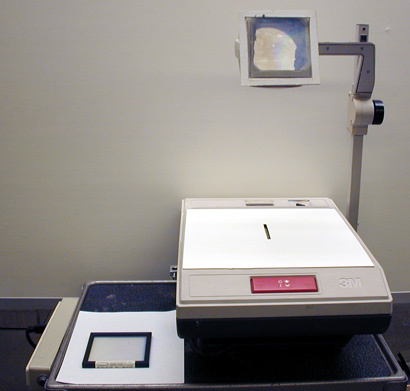
|

|
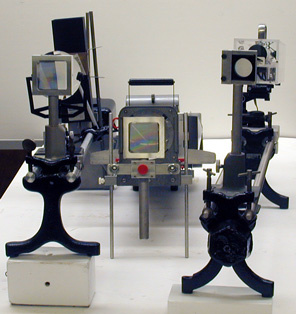
|

|
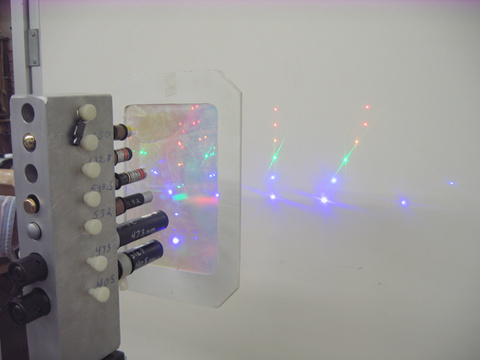
|
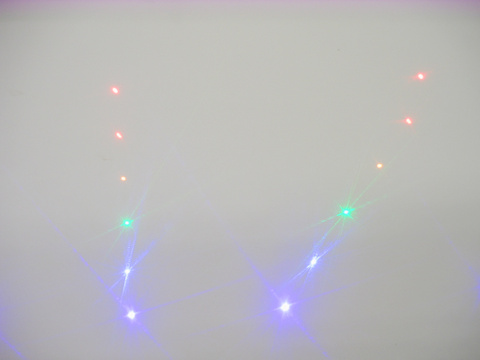
|
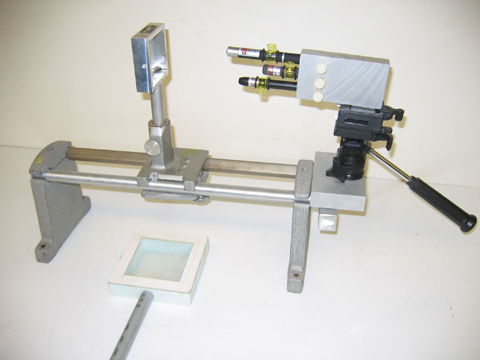
|
Code Number: 6D20.20
Demo Title: Gratings - Mercury, White Light, and Laser Spectra
Condition: Excellent
Principle: Refraction and Dispersion
Area of Study: Optics, Astronomy
Equipment:
Gratings (Transmission), Laser (2 to 5 mw.), Optics Table, White Light Projector, Mercury Spectrum Apparatus, Overhead Projector.
Procedure:
The laser array of 6 different colors can be found on the laser and Cornell plate cart.
The overhead projector has a strip of Velcro on the exit lens for a holographic grating. When used in conjunction with a cardboard slit plate a very intense first order spectrum is produced.
NOTE: The holographic grating has been designed with about 750 lines per millimeter. This is the maximum number of lines that can be used without cutting portions of the red end of the spectrum. This grating also is designed to put 95% plus of the light into the first order.
The most common use for the gratings is to use them in conjunction with a white light projector to produce a rainbow spectrum.
An interesting way to show how a grating works is to superimpose a combination of spectrums. First shoot the laser into one of the 6000 line/cm. gratings. You will get a central spot and two spots on the right and two spots on the left of the central spot. Next turn on the white light projector and show that the spots of the laser correspond to the proper red portion of the white light spectrum. Next turn on the mercury spectrum and show that the spectral lines correspond to the proper portions of the white light spectrum. Hints: The spectrums can be brought into the same degree of dispersion by moving the gratings farther or closer to the light sources. It is easiest to use the white light projector as the standard and move the gratings of the laser and mercury spectrums to correspond with it. It is easier to see the mercury spectrum if it is above the white light spectrum. When done properly and the central spots are all in alignment. 1st and 2nd order spectrums will all correspond to an amazing degree of accuracy.
The wavelengths of the main lines of mercury are:
Violet = 436 nm,
Green = 546 nm,
Yellow = 577 nm & 579 nm ( this is actually 2 lines )
Red = 691 nm.
You can also use laser pointers of different wavelength to show the different diffraction angles. The laser pointers we usually use have wavelengths of 650 nm, 632 nm ( same wavelength as a HeNe laser ), 593.5 nm, 532 nm, 473 nm, and 405 nm. The two red laser pointer spots will not be separated by much in the first order spectra but will have clearly visible separation in the second order spectra.
References:
- Stephen J. Van Hook, "Inquiry with Laser Printer Diffraction Grating", TPT, Vol. 45, # 6, Sept. 2007, p. 340.
- Bruce C. Palquist, "Interactive Spectra Demonstration", TPT, Vol. 40, # 3, p. 140, March 2002.
- Se-Yuen Mak, "Mass Production of Optics Gratings", TPT, Vol. 34, # 4, Apr. 1996, p. 214.
- Jukka O. Mattila, "Spectral Experiments With White Light", TPT, Vol. 32, # 6, Sept. 1994, p. 338.
- Philip Sadler, "Projecting Spectra for Classroom Investigations", TPT, Vol. 29, # 7, p. 423 - 427, October 1991.
- Alfred F. Leung and Simon George, "Which Side of the Grating Has the Grooves", TPT, Vol. 28, # 2, p. 98, February 1990.
- P. J. Ouseph, "Spectra of White and Black Lines", TPT, Vol. 27, # 6, Sept. 1989, p. 458.
- Frank A. Smith Jr., "Lecture-Demonstration Comparison of Two Spectra", TPT, Vol. 24, # 5, p. 285, May 1986.
- James A. Lock, "The Rotated Diffraction Grating - A Laboratory Experiment", TPT, Vol. 23, # 4, Apr. 1985, p. 226 - 228.
- P. D. Gupta, "Measurement of the Grating Element of an Optical Transmission Grating", TPT, Vol. 22, # 9, Dec. 1984, p. 583.
- Ninad R. Jetty, Akash Suman, Rajesh B. Khaparde, "Novel Cases of Diffraction of Light from a Grating: Theory and Experiment", AJP, Vol. 80, # 11, Nov. 2011, p. 972.
- Gilles Fortin, "Graphical Representation of the Diffraction Grating Equation", AJP, Vol. 76, # 1, p. 43, Jan. 2008.
- K. G. Vandervoort, S. L. Adams, and A. M. Hyder, "Revealing the Blaze Angle: A Simplistic Experiment for Visualizing Diffraction Effects Using Microscopic and Macroscopic Gratings", AJP, Vol. 74, # 7, July 2006, p. 649.
- James E. Kettler, "The Compact Disk as a Diffraction Grating", AJP, p. 367, Vol. 59, No. 4, April 1991.
- Laxman G. Phadke and Jim Allen, "Diffraction Patterns for the Oblique Incidence Gratings", AJP, p. 562, Vol. 55, No. 6, June 1987.
- Mu-Shiang Wu and Shu-Ming Yang, "Dispersion and Resolving Power of a Grating", AJP, Vol. 54, #8, Aug. 1986, p. 735.
- Myron A. Jeppesen, "Diffraction Gratings and Minimum Deviation", AJP, Vol. 38, #3, Mar. 1970, p. 382.
- D. H. Rank, "The Multiple-Slit Diffraction Pattern", AJP, Vol. 20, #7, Oct. 1952, p. 453.
- Louis R. Weber & Don l. Hammond, "Further Note on Measurement of Wavelength with a Diffraction Grating", AJP, Vol. 19, #9, Dec. 1951, p. 562.
- Robert Ehrlich, "Q.11 Diffraction-Grating Sheets", Turning the World Inside Out, p. 203.
- David Kutliroff, "18, Spectroscopy Demonstration with 35mm Projector", 101 Classroom Demonstrations and Experiments For Teaching Physics, p. 45.
- John H. Moore, Christopher C. Davis, Michael A. Coplan, "Diffraction Gratings", Building Scientific Apparatus 2nd Edition. p. 154-157.
- Gordon McComb, "Diffraction Gratings", Lasers, Ray Guns, & Light Cannons, p. 43-44.
- "19, Continuous Spectrum with a Diffraction Grating", Experiments in Optics, Part 1, J. Klinger Scientific Apparatus Corp., Bulletin 101.
- T. D. Rossing, C. J. Chiaverina, "# 8, Diffraction from Compact Disc", Light Science, Physics and Visual Arts, p. 126.
- T. D. Rossing, C. J. Chiaverina, "# 4, Fluorescent Plastics", Light Science, Physics and Visual Arts, p. 148.
- T. D. Rossing, C. J. Chiaverina, "8.1, Spectral Color", Light Science, Physics and Visual Arts, p. 174.
- T. D. Rossing, C. J. Chiaverina, "Experiment 5.3, Diffraction From Tracks Of A Compact Disc", Light Science, Physics and Visual Arts, p. 396.
- T. D. Rossing, C. J. Chiaverina, "Experiment 6.2, Spectrum Analysis With A Diffraction Grating", Light Science, Physics and Visual Arts, p. 400.
- "Diffraction Grating, Simple", Selective Experiments in Physics, CENCO, 1962.
- "The Diffraction Grating", Selective Experiments in Physics, CENCO, 1962.
- W. Bolton, "The Diffraction Grating", Book 2 - Waves and Particles, Physics Experiments and Projects, 1968, p. 33-34.
- Raymond Bruman, "Diffraction", Exploratorium Cookbook I, p. 7.1 - 7.2